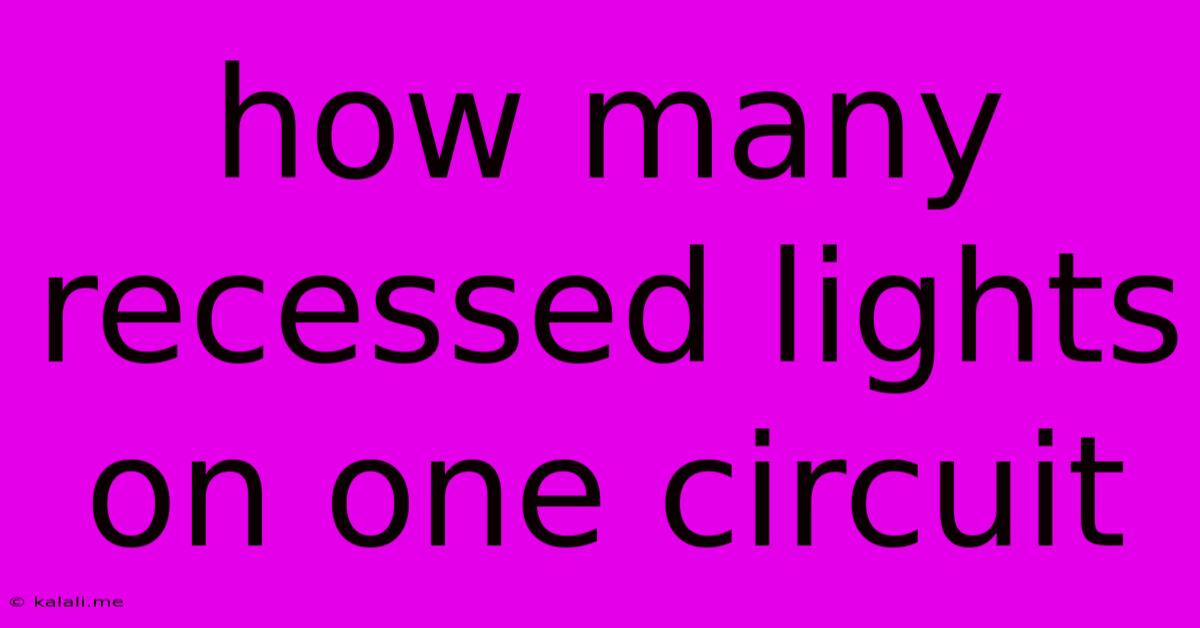How Many Recessed Lights On One Circuit
Kalali
Jun 02, 2025 · 3 min read

Table of Contents
How Many Recessed Lights Can You Put on One Circuit? A Comprehensive Guide
Determining the maximum number of recessed lights on a single circuit is crucial for safe and efficient home electrical systems. Overloading a circuit can lead to overheating, blown fuses or breakers, and even fire hazards. This guide breaks down the factors influencing this limit and provides a practical approach to planning your lighting installation.
Understanding Electrical Circuits and Amperage
Before diving into the specifics of recessed lighting, let's establish a basic understanding of electrical circuits. A circuit's capacity is determined by its amperage rating, typically 15 amps or 20 amps in most homes. Each circuit has a breaker that trips if the current exceeds its rating, protecting your wiring from damage.
The wattage of your recessed lights is a crucial factor. The total wattage of all fixtures on a circuit shouldn't exceed the circuit's capacity, calculated using the formula:
Watts = Amps x Volts
In a standard 120-volt US household system:
- 15-amp circuit: 15 amps x 120 volts = 1800 watts
- 20-amp circuit: 20 amps x 120 volts = 2400 watts
Important Considerations Beyond Simple Wattage Calculations
While the wattage calculation provides a starting point, it's not the only factor. Several other elements can influence the number of recessed lights you can safely install on a single circuit:
- Fixture Wattage: Recessed lights come in various wattages. LED lights, known for their energy efficiency, typically use much less wattage than incandescent or halogen bulbs. This allows for more fixtures on a single circuit. Always check the individual fixture's wattage rating.
- Other Devices on the Circuit: It's unlikely a circuit is dedicated solely to recessed lights. Other appliances or electrical devices sharing the same circuit will reduce the available wattage for your lighting. Consider other electrical needs on the same circuit, such as outlets or fans, which will decrease the number of recessed lights you can safely use.
- Voltage Drop: Long wire runs can lead to voltage drop, reducing the voltage reaching your lights. This is especially important with high-wattage fixtures and longer runs. Consider using thicker gauge wiring to minimize voltage drop over long distances.
- National Electrical Code (NEC): Always adhere to local electrical codes and consult a qualified electrician. The NEC provides guidelines for safe electrical practices, including the maximum number of fixtures per circuit. This is important to ensure the safety and longevity of your electrical system.
- Derating: The NEC requires "derating" the amperage capacity of circuits when several conductors (wires) run inside the same conduit or junction box. This reduces the effective amperage, limiting the number of fixtures. Proper conduit sizing and wire selection are vital here.
Practical Approach and Safety Recommendations
To ensure safety and avoid overloading your circuits, it's best to err on the side of caution. Here are some practical recommendations:
- Start with LED Recessed Lights: LEDs significantly reduce the total wattage consumption, allowing for more lights on a single circuit.
- Use a Dedicated Circuit: If possible, dedicate a separate circuit solely to your recessed lighting. This eliminates the need to account for other devices and reduces the chances of overloading.
- Consult an Electrician: For complex installations or if you're unsure about any aspect of your electrical system, consult a qualified electrician. They will accurately assess your specific needs and ensure compliance with all relevant codes.
- Plan Your Lighting Layout: Before starting the installation, plan the placement and number of recessed lights carefully. This will help you determine the necessary circuit capacity and wiring needs.
Conclusion
While a simple calculation using wattage and amperage provides a rough estimate, various factors affect the actual number of recessed lights you can put on one circuit. Prioritizing safety, understanding the NEC, and working with a qualified electrician will ensure a safe and efficient lighting installation that meets your needs without compromising the integrity of your electrical system.
Latest Posts
Latest Posts
-
How Long To Soak Red Beans
Jun 04, 2025
-
Was Jesus Crucified On The Passover
Jun 04, 2025
-
Fortune Cowsay Lolcat Not Working In Zshrc
Jun 04, 2025
-
Bathroom Sink Drains Slow No Clog
Jun 04, 2025
-
No Toilet Flush Drains Backed Up Gurgling
Jun 04, 2025
Related Post
Thank you for visiting our website which covers about How Many Recessed Lights On One Circuit . We hope the information provided has been useful to you. Feel free to contact us if you have any questions or need further assistance. See you next time and don't miss to bookmark.